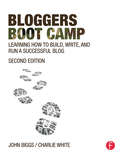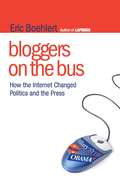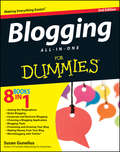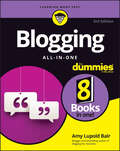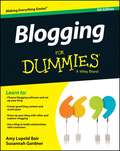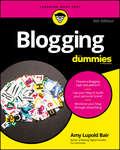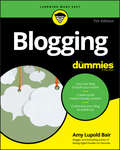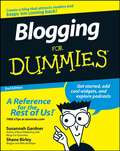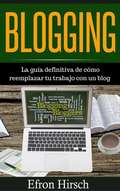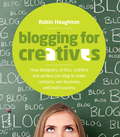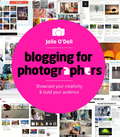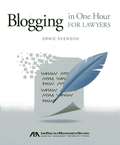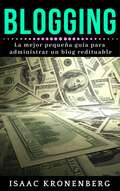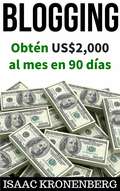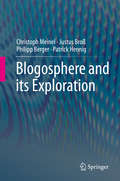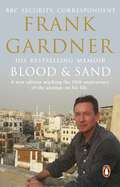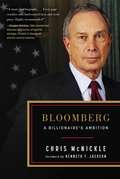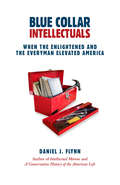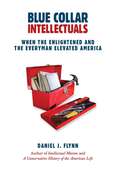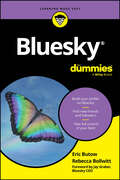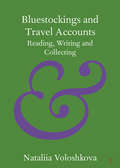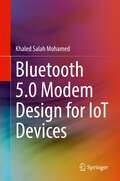- Table View
- List View
Blogger- und Influencer-Marketing in der Praxis: Alles Wichtige für gelungene Kooperationen zwischen Unternehmen, Bloggern und Influencern
by Rita AngeloneDieses Buch gewährt Einblicke in die Welt der Blogger und Influencer und zeigt auf, wie eine Zusammenarbeit für alle Akteure erfolgreich sein kann.Der Autorin Rita Angelone, selbst Bloggerin der ersten Stunde, gelingt es, den Prozess des Blogger- und Influencer-Marketings von der Strategieentwicklung, über Vertragsverhandlung, Auftragserteilung und Umsetzung bis hin zum Controlling aus der Sicht der verschiedenen Beteiligten greifbar zu machen. Anhand von Praxistipps und Best-Practice-Beispielen zeigt sie alle erfolgsentscheidenden Faktoren und Handlungsoptionen auf.Das Werk liefert sowohl interessierten Laien als auch erfahrenen Praktikern leicht nachvollziehbare Ansätze, es zeigt Spannungsfelder, Grenzen sowie Chancen auf und regt dazu an, Blogger- und Influencer-Marketing nach rechtlichen und ethischen Grundsätzen sinnvoll und nachhaltig einzusetzen.
Bloggers Boot Camp: Learning How to Build, Write, and Run a Successful Blog
by Charlie White John BiggsAnyone can build a blog. It’s quite easy. The difficult part is keeping it relevant, technically sound, and popular. Bloggers Boot Camp shows you how to blog for success. It teaches you how to find a niche, find your unique voice, and how to hold a conversation with an audience. It provides information on all the right tools for the blog, and it offers best ways to promote your blog and content for maximum success and a profitable life. Though rules in creating compelling content haven’t really changed, ways in which the world blogs has since the last edition. The authors have learned a lot about social media since writing the previous edition’s manuscript. They understand and know how social media can make or break a blog. Microblogging is a new trend brought on by the wide utilization of social media. To that same end, networking with other bloggers and content creators on the web is another form of building one’s blog and one’s reputation as a writer.
Bloggers on the Bus: How the Internet Changed Politics and the Press
by Eric BoehlertSince the entry of radio into American homes, technology has led the way for political campaign strategies. Boys on the Blog will offer the first detailed look at the latest revolution in campaign strategy-- the blogosphere. Liberal politcking in particular has been radically impacted by these grassroots, often individual efforts over the last few years. This ad-hoc, mostly pro bono, community (aka the Netroots) has been able to change, in telling and significant ways, American politics and media. Using the 2008 presidential White House campaign as a dramatic and compelling backdrop, the book will detail the myriad of ways that the blogs influenced the candidates and the campaigns. Colored by vivid portraits and character sketches, this book will reveal the new wave of changes that has revolutionized progressive politics.
Blogging All in One For Dummies, 2nd Edition
by Susan GuneliusA complete update to the ultimate reference guide on blogging basics! The increase in the number of blogs is seemingly endless and continues to grow at a phenomenal rate, thanks in part to the rise of smartphones, tablets, and blogging applications. With this kind of popularity, how can a blogger stand out from the rest of the masses? This all-in-one guide is packed with detailed information and advice that helps you create and solidify your place in the blogosphere. You'll learn how to get started, use blogging tools, collaborate with other bloggers, become a part of mobile blogging, and much more. Covers getting started, working with blogging software, other tools, blog marketing, microblogging (including Twitter), making money with your blog, and corporate and niche blogging Helps new bloggers become active and productive members of the blogging community Provides vital information for both hobby bloggers and those who want to build a career around blogging Blogging All-in-One For Dummies, 2nd Edition cuts through the clutter and offers you a fun and friendly reference guide to starting and maintaining a successful blog.
Blogging All-in-One For Dummies: A Wiley Brand
by Amy Lupold BairBlog with the best of ‘em! If you’re looking for a complete guide to creating and solidifying your place in the blogosphere, you’ve come to the right place! With 8 books in one, Blogging All-in-One For Dummies is the only resource you’ll need to get started or to improve your existing blog. Learn about the most popular blogging platforms, creating content worth reading, and methods for driving traffic to your blog. Cut through the confusion and find the facts about monetizing your blog, using the best blogging tools for you, and increasing reader engagement to become an active, successful member of the blogging community. You're ready to start blogging, so let Dummies show you the way! Perfect your blog idea and choose the best platform for you Get people to read your blog through search engine optimization and social media promotion Learn about the latest trends in the blogosphere Make money from your blog with creative monetization ideasBloggers of all skill and experience levels will find valuable information in Blogging All-in-One For Dummies.
Blogging For Dummies
by Susannah Gardner Amy Lupold BairThe best book on blogging, updated and better than ever!The blogosphere keeps changing and evolving, and so does this top blogging guide. A terrific book whether you're just starting out or are already blogging regularly, this book provides solid information on blogging basics, the anatomy of a good blog, and the tools you need to get started. You'll learn how to set up an account, find ample coverage of social plug-ins and emerging platforms like Squarespace and Overblog, and discover savvy ways to write your first post. Best of all, the book explores how you can make real money from your passion and become a professional blogger.Updates you on the latest blogging software and utilitiesExplains search engine optimization, so new readers will find your blogReviews advertising tools and techniques you can use to attract readersHelps you integrate your blog with social mediaDelves into professional blogging and how to make money from your blogStart blogging like a professional with the new edition of this top guide, Blogging For Dummies, 5th Edition.
Blogging For Dummies
by Amy Lupold BairThe bestselling guide to blogging--updated and better than ever! Are you ready to make your mark on the Internet with a personal blog, but aren't quite sure where to start? Blogging For Dummies gives you the lowdown on blogging basics, the anatomy of a good blog, and all the tools you need to get started. Plus, you'll find advice on choosing a blog topic, picking a domain name and host, writing your first blog post, planning an editorial calendar, and much more. Whether you're interested in casual blogging or creating a more professional online presence, Blogging For Dummies covers it all--and makes it easier than ever to put your thoughts and words out to the masses. Updated to include coverage of the latest trends and techniques in the blogosphere--like technology changes in blogging software and social media--it helps you choose a blogging platform, use SEO effectively to drive traffic to your blog, create content that's pinnable and shareable, and integrate your blog with social media through plug ins. Best of all, you'll discover how you can make real money from your passion and become a professional blogger. Choose a blogging topic and platform Use your blog to build your personal brand Monetize your blog through advertising and sponsorships Create content that easily integrates with social media Blogging is a great way to express yourself, build and audience, and test out your ideas, and Blogging For Dummies will help you jump in with both feet!
Blogging For Dummies
by Amy Lupold BairThe bestselling blogging book—updated in a new edition! Ready to make your mark on the online world? Start a blog! Blogging For Dummies provides you with information on blogging basics, the anatomy of a good blog, and the tools required to get started. Plus, you'll get advice on a blog topic, choosing a domain name and host, writing your first post, planning an editorial calendar, and using your blog as an important part of your personal brand. Decide which of the major blogging platforms will work for you Use SEO to drive traffic to your blog Monetization through advertising and sponsorships Create content that draws readers in Covering shifts in popular blogging platforms and tools, changes in social media, and the latest best practices in the blogosphere, this new edition sets you up for blogging success!
Blogging For Dummies
by Shane Birley Susannah GardnerEverybody's doing it! And while that logic never got far with your mother, it's a fine reason to start blogging, especially if you have a business to build or a cause to promote. Well-run blogs do more than offer an outlet for your thoughts. They've actually influenced everything from a company's image to the outcome of a local election.Because the blogosphere is pretty crowded, it's a good idea to find out a bit about the anatomy of a blog, what makes a good one, and what it takes to keep one going before you dive right in and start sharing with the world. Blogging For Dummies, 2nd Edition gives you all the basics so you can get a good start. And if you've been around the blog a few times and want to advance to the next level, Blogging For Dummies, 2nd Edition even takes a look at podcasting and videoblogging.You'll find out how to:Make your blog stand out in a crowd, build an audience, and even make it payChoose the best software options, boost readership, and handle commentsGenerate revenue from your blog with ads and sponsorshipsProtect your privacy and your jobDeal with spam and the inappropriate comments from that guy who posts several times a dayFind your nicheAttract and keep readersUse your blog to promote your business, cause, or organizationAdd audio, video, cool widgets, and moreReady? Get Blogging for Dummies and let's get started!
Blogging La guía definitiva de cómo reemplazar tu trabajo con un blog
by Efron Hirsch Michelle Vergara¿Estás intentando empezar un blog rentable? Este libro te mostrará exactamente lo que necesitas hacer para empezar un blog rentable, basado en lo que están haciendo los mejores blogueros. Si sigues las instrucciones, tendrás un blog increíble y rentable en muy poco tiempo. Aquí hay una vista previa de lo que aprenderás... Cómo construir un blog Cómo elegir un nicho Cómo diseñar tu blog Cómo empezar a crear entradas Cómo crear contenido valioso para tu blog Cómo generar tráfico Cómo monetizar tu blog Y mucho, mucho más
Blogging for Creatives: How Deisgners, Astists, Crafters And Writers Can Blog To Make Contacts, Win Business And Build Success
by Robin HoughtonBlogging for Creatives teaches you everything you need to know about how to design and profit from a beautiful blog that people will want to return to again and again. Complete with hundreds of tips, tricks and motivational stories from artistic bloggers who have started from scratch, Blogging for Creatives covers how to publish and host a blog, as well as keeping it fresh, staying motivated and forging connections. Whether you?re looking to create a platform for your creative trade, an inspirational journal, or a hub for people with similar tastes and interests, learn how to benefit from being part of the blogosphere in this accessible, non-techie guide.
Blogging for Creatives: How Deisgners, Astists, Crafters And Writers Can Blog To Make Contacts, Win Business And Build Success
by Robin HoughtonBlogging for Creatives teaches you everything you need to know about how to design and profit from a beautiful blog that people will want to return to again and again. Complete with hundreds of tips, tricks and motivational stories from artistic bloggers who have started from scratch, Blogging for Creatives covers how to publish and host a blog, as well as keeping it fresh, staying motivated and forging connections. Whether you're looking to create a platform for your creative trade, an inspirational journal, or a hub for people with similar tastes and interests, learn how to benefit from being part of the blogosphere in this accessible, non-techie guide.
Blogging for Photographers: Showcase Your Creativity & Build Your Audience
by Jolie O'DellPhotography is a dominant force in the blogosphere, and the potential reach and influence of a successful blog is something photographers of all levels can hardly ignore - but where to begin? Veteran blogger Jolie O'Dell shares the secrets of finding success online with reliable and inspirational methods for building, maintaining, and promoting your own personal photo blog. Your images will find new audiences, your voice will be heard across the web, and your business will grow by leaps and bounds!> Dozens of inspirational blogs featured throughout show off some of the very best work done today.> Loaded with tips on how to consistently create content that's fun for you and your readers.> Learn how to engage your readership and interact with the global community.
Blogging in One Hour for Lawyers
by Ernie SevensonUntil a few years ago, only the largest firms could afford to engage an audience of millions. Now, lawyers in any size firm can reach a global audience at little to no cost—all because of blogs. An effective blog can help you promote your practice, become more "findable" online, and take charge of how you are perceived by clients, journalists and anyone who uses the Internet. Blogging in One Hour for Lawyers will show you how to create, maintain, and improve a legal blog—and gain new business opportunities along the way. In just one hour, you will learn to: • Set up a blog quickly and easily • Write blog posts that will attract clients • Choose from various hosting options like Blogger, TypePad, and WordPress • Make your blog friendly to search engines, increasing your ranking • Tweak the design of your blog by adding customized banners and colors • Easily send notice of your blog posts to Facebook and Twitter • Monitor your blog's traffic with Google Analytics and other tools • Avoid ethics problems that may result from having a legal blog
Blogging: La mejor pequeña guía para administrar un blog redituable
by Isaac KronenbergSeguro que ya has escuchado esto antes, sólo escoge el nicho apropiado, escribe buenos artículos, esparce vínculos de afiliación por todos lados, y obtendrás ganancias. Bueno, ¡tengo noticias para ti! ¡Eso NO es lo que hacen los blogueros que obtienen grandes ganancias! Aunque hay algo de cierto en el hecho de que parte de la ecuación es generar vínculos de afiliación para tu blog, sólo esparcirlos al azar y esperar que alguien de un cliqueo no es una buena estrategia en absoluto. Entonces, este libro se concentra en revelarte exactamente lo que los blogueros que obtienen grandes ganancias realmente hacen (que es lo que hago exactamente yo). No cometas errores, la mayoría que comienza un blog no tiene ni idea de cómo monetizarlo, y fallan en lograr que el blog sea redituable; esa es la realidad, tu competición es muy baja si haces las cosas bien, si haces lo que te indico en este libro. De hecho, no tendrás que leer otro libro sobre blogging nuevamente porque sabrás exactamente lo que tienes que hacer para monetizar tu blog. Confía en mí, este libro será el mejor libro sobre blogging que jamás hayas leído, y te mostrará un mapa muy real y directo para asegurarte que obtengas ganancias desde tu blog. La única manera de fracasar es no implementar el método que te enseñaré, así que asegúrate no sólo de leer este libro en forma pasiva sino realmente aplicando lo que te vaya indicando, ya que estoy absolutamente seguro de que logrará llevar tu blog a otro nivel.
Blogging: Obtén US$ 2000 al mes en 90 días
by Isaac Kronenberg¡Isaac Kronenberg lo logra de nuevo, otro libro fascinante sobre blogging que va más allá de cualquier otro libro que ya exista! Este último libro de Kronenberg es el libro sobre blogging más avanzado del mercado, enseñando nada más ni nada menos que las estrategias más efectivas de monetizar que existen para obtener un blog que genere de cero a US$2000 por mes en 90 días. Todo lo que está incluido en este libro está basado en estrategias reales utilizadas por blogueros que generan muchos ingresos en la actualidad. Ya sea que seas nuevo en el blogging o un bloguero avanzado, si existe una píldora mágica que puede llevarte de cero a generar un ingreso a tiempo completo de un blog, entonces este libro es el objeto más cercano que existe a esa píldora mágica. Si en serio te propones generar ingresos con el blogging, entonces este libro será el mejor libro que hayas leído acerca del tema.
Blogosphere and its Exploration
by Christoph Meinel Justus Broß Philipp Berger Patrick HennigThis book represents an attempt to fully review the phenomenon of the blogosphere. The intention is to provide a reliable guide to understanding and analyzing the world of the unimaginable number of diverse blogs, each consisting of innumerable posts, which in their entirety form the blogosphere. We go on to answer the questions of how to grasp the complexity of the blogosphere and extract useful knowledge from it. In setting out to write this book, our central aim was to increase the reader's awareness and understanding of the blogosphere phenomenon, including its structure and characteristics. This can be achieved through a better understanding of individual blogs and their particular technical characteristics, as well as a deeper knowledge of how a single blog is embedded and interconnected within the entire blogosphere. The shape and form of the blogosphere can be described using the analogy of different continents. In our description the defining features and characteristics of the continents are illustrated by paradigmatic example blogs. Following on from the structural analysis we provide details of the available methods and describe the complex challenge of automatically retrieving information from the abundance of data contained in the blogosphere. Finally, we present our blog search platform, called BLOGINTELLIGENCE and describe all the tools and features we have developed during the last couple of years to explore the blogosphere.
Blood and Sand: The BBC security correspondent’s own extraordinary and inspiring story
by Frank GardnerOn the June 6, 2004, while on assignment in Riyadh, BBC security correspondent Frank Gardner and cameraman Simon Cumbers were ambushed by Islamist gunmen. Simon was killed outright. Frank was hit in the shoulder and leg. As he lay in the dust, a figure stood over him and pumped four more bullets into his body at point-blank range...Against all the odds, Frank Gardner survived. Today, although partly paralysed, Frank continues to travel the world, reporting and making documentaries for the BBC. This acclaimed memoir was brought up to date with a new chapter that recounted his return to Saudi Arabia for the first time since he was shot and the story he tells continues to move and inspire, and remains an affirmation of his deep understanding of - and affection for - the Islamic world in these uncertain times.___'Gardner tells his remarkable tale well and bravely, with an astonishing lack of anger and enduring love and respect for the Islamic world' SUNDAY TIMES'Brave, unsentimental and genuinely inspiring' EVENING STANDARD 'What makes Gardner's moving, often humorous, deeply personal story so important is the fact that he has woven into it a brilliantly dispassionate, clear-eyed account of the Islamic world' SCOTSMAN'A witty, self-deprecating, inspiring testament' DAILY TELEGRAPH
Bloomberg: A Billionaire's Ambition
by Chris McNickleExamine the Bipartisan Legacy of a Remarkable Billionaire PoliticianBloomberg: A Billionaire’s Ambition tells the story of how one of America’s most successful entrepreneurs was elected mayor of New York City and what he did with the power he won. Bloomberg’s stunning victory against all odds just weeks after the 9/11 terrorist attack left him facing challenges unlike any mayor in history. For the next twelve years, he kept the city safe, managed budgets through fiscal crises, promoted private sector growth, generated jobs, built infrastructure, protected the environment, supported society’s cultural sensibilities, and achieved dramatic improvements in public health. Bloomberg was an activist executive who used government assets boldly and wisely for the greatest good, for the greatest number of people. His time as mayor was not without controversy. Bloomberg supported stop and frisk police tactics that a judge ruled unconstitutional, and jailhouse violence rose to levels so severe the federal government intervened. The administration’s homeless policies were ineffective. And he forced a change in the city charter to allow him to serve a third term. Overall, record low crime and the lasting impact of innovative policies will cause his tenure to be remembered as a remarkable success. Having returned to his global media empire, and to his private philanthropy, Bloomberg continues to challenge the National Rifle Association on gun control, promote national education reform, and support policies to combat climate change. Frequently touted as an independent candidate for president, Bloomberg leaves behind a legacy of effective government.
Blue Collar Intellectuals
by Daniel FlynnStupid is the new smart--but it wasn't always soPopular culture has divorced itself from the life of the mind. Who has time for great books or deep thought when there is Jersey Shore to watch, a txt 2 respond 2, and World of Warcraft to play?At the same time, those who pursue the life of the mind have insulated themselves from popular culture. Speaking in insider jargon and writing unread books, intellectuals have locked themselves away in a ghetto of their own creation.It wasn't always so.Blue Collar Intellectuals vividly captures a time in the twentieth century when the everyman aspired to high culture and when intellectuals descended from the ivory tower to speak to the everyman. Author Daniel J. Flynn profiles thinkers from working-class backgrounds who played a prominent role in American life by addressing their intellectual work to a mass audience. Blue Collar Intellectuals shows us how much everyone--intellectual and everyman alike--has suffered from mass culture's crowding out of higher things and the elite's failure to engage the masses.
Blue Collar Intellectuals: When the Enlightened and the Everyman Elevated America
by Daniel J. FlynnStupid is the new smart—but it wasn&’t always so Popular culture has divorced itself from the life of the mind. Who has time for great books or deep thought when there is Jersey Shore to watch, a txt 2 respond 2, and World of Warcraft to play? At the same time, those who pursue the life of the mind have insulated themselves from popular culture. Speaking in insider jargon and writing unread books, intellectuals have locked themselves away in a ghetto of their own creation. It wasn&’t always so. Blue Collar Intellectuals vividly captures a time in the twentieth century when the everyman aspired to high culture and when intellectuals descended from the ivory tower to speak to the everyman. Author Daniel J. Flynn profiles thinkers from working-class backgrounds who played a prominent role in American life by addressing their intellectual work to a mass audience. Blue Collar Intellectuals tells the fascinating story of the unschooled hobo who migrated from skid row anonymity to White House chats with the president and prime-time TV specials. Blue Collar Intellectuals tells the fascinating story of: •The scandalous teacher-student romance that spawned a half-century labor of love in writing the history of the world. •The Ivy League Ph.D. who held neither a high school nor college degree, and fittingly launched a renaissance in reading the great books outside of formal schools. •The scholarship student who experienced the free market firsthand waiting tables and peddling socks, and who became one of capitalism&’s most influential exponents. •The impoverished outcast who became the poet of the pulps, elevating millions of readers along with heretofore marginal genres. Guiding us through a world now vanished, Flynn causes us to look anew at our own digital age and its nostrums: Video gaming is just a new form of literacy, Reality shows . . . Challenge our emotional intelligence, and Who cares if Johnny can&’t read? The value of books is overstated. Blue Collar Intellectuals shows us how much everyone intellectual and everyman alike has suffered from mass culture&’s crowding out of higher things and the elite&’s failure to engage the masses.
Blue Extinction in Literature, Art, and Culture (Palgrave Studies in Animals and Literature)
by Rachel Murray Vera FibisanBlue Extinction in Literature, Culture, and Art examines literary and cultural representations of aquatic biodiversity loss, bringing together critical perspectives from the blue humanities and extinction studies. It demonstrates the affordances, as well as the limitations, of literary and artistic forms in exposing the plight of aquatic organisms, drawing attention to the social, political, and economic structures that are contributing to their destruction. Together, the essays in this collection demonstrate how literature and art can challenge dominant cultural conceptions and lingering misconceptions surrounding aquatic biodiversity loss, offering new ways of relating to species ranging from whales to oysters.
Bluesky For Dummies
by Eric Butow Rebecca BollwittThe first and most trustworthy guide to the hot new social media platform Bluesky has been taking the social media world by storm. The platform offers users a high degree of control over what information they view and share, abilities they've lost on other platforms. Bluesky For Dummies serves as your guidebook to navigating the new platform. Learn to import your contacts, control your feed, and share content, with easy-to-follow instructions. This book also shows you how to manage who can contact you and access your content, so you can avoid bots, trolls, and other unsavory characters. For business owners, this Dummies guide is a breath of fresh air—learn how to set up Bluesky for your business and enjoy a peaceful and profitable social experience. Discover how Bluesky differs from the other social media apps out there Create a profile, make connections, share your content, and build a following Take control of your social media experience with access and content settings Connect with users by exploring custom lists and feeds Refugees from other social media sites, as well as social media beginners, can find out what it's like to be social without the downsides, thanks to Bluesky For Dummies.
Bluestockings and Travel Accounts: Reading, Writing and Collecting (Elements in Publishing and Book Culture)
by Nataliia VoloshkovaThis Element proposes to relate the eighteenth-century world of travel and travel writing with the bluestocking salon. It locates eminent British travellers and explorers in the female-presided intellectual space and examines their multifaceted interaction with the bluestockings between 1760 and 1799. The study shows how the bluestockings acquired knowledge of the world through reading, discussing, writing and collecting travel accounts. It explores the 'social life' of manuscript and printed travel texts in the circle, their popularity and impact on the bluestockings. This Element builds upon the body of evidence provided by their published and unpublished diaries, correspondence and private library catalogues.
Bluetooth 5.0 Modem Design for IoT Devices
by Khaled Salah MohamedThis book provides an introduction to Bluetooth technology, with a specific focus on developing a hardware architecture for its modem. The major concepts and techniques involved in Bluetooth technology are discussed, with special emphasis on hardware mapping. The book starts simply to allow the reader to master quickly the basic concepts, before addressing the advanced features. This book differs from existing content in that it presents Bluetooth Transceiver architecture suitable for implementation in an FPGA for IoT Devices. It will examine several digital algorithms for modulation and demodulation of Bluetooth signals, locking on the carrier phase, and synchronizing the symbol. Many of these previously analog designs have been translated to the digital domain.

